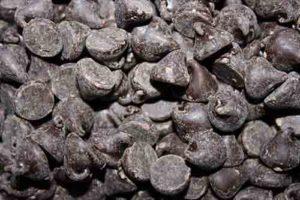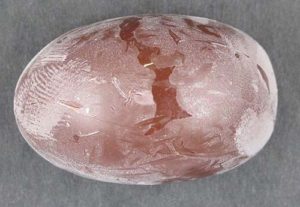On the few times I’ve had to open up my emergency food, I’m always glad that I stockpiled luxuries like olive spread to jazz up bland crackers, marshmallows to roast on my indoor emergency stove, and canned artichokes to serve with my endless rice supply.
But chocolate is by far the best luxury prepping food you can stockpile.
If you are thinking of storing chocolate long-term, here is what you need to know about its shelf life, which types of chocolate are best to stockpile, and how to package it.
Does Chocolate Go Bad?
Plain chocolate generally does not go bad in the sense that it becomes unsafe to eat. This is because chocolate has very little moisture and is considered “microbiologically safe.”
However, if stored for a long time, the fats in chocolate can go rancid and give it a bad taste. The good news is that cocoa in chocolate contains natural antioxidants, so the chocolate doesn’t go rancid as quickly as other fatty foods like powdered milk or cooking oil. (Read about cocoa powder shelf life.)
Chocolate can also change appearance and texture when stored for a long time. The fats and sugars can migrate to the outside and cause “bloom” – a whitish film on the outside of the chocolate. It is still safe to eat but does not look as appealing.
Chocolate Shelf Life
The shelf life of chocolate is approximately 9-24 months. It varies depending on the type of chocolate and storage conditions. Dark chocolate has the longest shelf life, followed by plain milk chocolate. White chocolate and chocolates with fillings have shorter shelf lives.
Note that these shelf life guidelines do not indicate when the chocolate will become unsafe to eat. Instead, they are a guideline of how long it will take before the chocolate develops bloom, changes texture or becomes rancid.
*Temperate conditions means 26.6 °F to 64.4 °F. Tropical conditions are above 64.4°F.
| Type of Chocolate | Temperate Conditions | Tropical Conditions |
|---|---|---|
| Dark Chocolate | 24 months | 24 months |
| Milk Chocolate | 16 months | 12 months |
| White Chocolate | 16 months | 12 months |
| Chocolate with Cream Filling | 18 months | 12 months |
| Chocolate with Nuts | 12 months | 9 months |
Is It Safe to Eat Expired Chocolate?
It is generally safe to eat expired chocolate. If the fats have started to go rancid, they may have an unpleasant sour taste, but they should not make you sick. In some rare cases, chocolate causes Salmonella poisoning, but it is highly unlikely that you’d get food poisoning from eating expired chocolate.
To play it safe, look for signs of bacterial growth, such as a fuzzy green film on the chocolate. It is easy to confuse chocolate bloom with bacteria growth, though.
Below are some pictures of chocolate with sugar bloom and fat bloom. It is not mold, and they are safe to eat.


Which Type of Chocolate Is Best for Long-Term Storage?
If you want to store chocolate long-term for emergency preparedness, opt for plain dark chocolate.
Milk chocolate is also okay for long-term storage, but choose bars that have stabilizers like antioxidants or soy lecithin added to them. Avoid any chocolate with nuts, fruits, creams, or wafers.
How to Store Chocolate Long Term
1. Keep It Cool
Temperature is the most important thing for long-term chocolate storage. Warm temperatures can cause the fats in the chocolate to go rancid. Try to keep the chocolate in a cool place that is less than room temperature.
2. Repackage in Airtight Packaging
Oxygen will also cause the fats in chocolate to oxidize. Exposure to humid air can also cause the chocolate to get wet, allowing bacteria to grow.
To prevent this, you can repackage the chocolate in airtight packaging. Mylar bags with oxygen absorbers is the best option. Vacuum sealer bags are not a good long-term solution because the bags will eventually allow air and moisture through.
Usually, you would need to remove food from its original packaging before putting it in Mylar. This is not the case with chocolate: you can put wrapped bars directly into the Mylar. The reason is that, unlike with packages of crackers or cereal, there’s very little air around the wrapped chocolate bar.
Read:
3. If Kept in Original Packaging
While Mylar + oxygen absorbers are the best way to store chocolate long-term, you can keep it in its original packaging. In this case, you must ensure it is kept somewhere cool, dry, and dark.
Ideally, you would rotate through the chocolate within 2 years. This limits the amount of chocolate you can stockpile for emergencies, though.
Do you stockpile chocolate for emergency prep? Let us know what other luxury items you have stockpiled in the comments section below.
https://www.researchgate.net/profile/Gajanan-Deshmukh/publication/319202581_Shelf_Life_Study_of_Guava_Milk_Chocolate/links/5f2e2961299bf13404ada5d4/Shelf-Life-Study-of-Guava-Milk-Chocolate.pdf
https://www.researchgate.net/profile/Isabell-Rothkopf/publication/308505829_Comparing_Storage_Tests_for_Chocolate_Shelf_Life_Prediction/links/57e509dd08aed68d52f2a2cc/Comparing-Storage-Tests-for-Chocolate-Shelf-Life-Prediction.pdf
https://onlinelibrary.wiley.com/doi/abs/10.1111/j.1745-459X.2004.tb00141.x
https://www.academia.edu/5027101/The_Manufacturing_Confectioner_at_BULLET_February
https://www.sciencedirect.com/book/9781855735002/the-stability-and-shelf-life-of-food
https://foodsafety.osu.edu/blog/april-27-2020-1126am/chocolate-production-microbial-prospective



When I was a young Sailor and stationed at the Air Base in San Diego in 1956. We found some WWII candy bars in the attic of one of the hangers. There was no insulation so I imagine these chocolate bars were subjected to extreme heat over the years and they were wrapped in something, from the time, and placed in cardboard boxes. Being young we were always Hungary so we ate some of them. As I remember they were not very good but knowing C-Rations I would think even when they were fresh they would not have been very good.
Can the chocolate (like chocolate chips) be placed in a mason jar and vacuum sealed?
Yes, that will help it stay good for longer. But it will still go rancid eventually if exposed to heat.
Would a moisture absorber help as well? Mylar, Oxygen absorber, and desiccant, that overkill or not really add shelf time?
For chocolate, you really don’t need a desiccant. They are for foods which absorb moisture, like dried fruit. In any case, when using desiccants andOAs together, the desiccant needs to be at the BOTTOM of the Mylar bag and the OA on the top (because OAs need a tiny bit of moisture to work).
Should an oxygen absorbor be added to chocolate bars in original packaging which are stored in a Mylar bag?
Wouldn’t hurt… It would, the goal is to remove the oxygen to prevent Oxygen from degrading your food.
Ideally, yes. The OAs improve shelf life. 🙂
What CC of oxygen absorbers would be best for a gal bag of milk chocolate chips?
If you use a 1-gallon mylar bag or 1-gallon jar, then you would use 1-2 300cc oxygen absorbers. So, a total of 300-600cc OA. I hope that helps.
I’d use at least 625cc for a 1-gallon bag. If you want to play it really safe, throw in an extra OA. It’s hard to tell how much air is INSIDE the actual cookies in addition to around them.
While in the Marines, I ate “survival” chocolate bars that were at least 10 years old. They were probably 95% dark chocolate and had that white “bloom” you mention in the article. They seemed fine to eat.
Thanks for writing. Excellent information.
James I remember those same chocolate bars. Probably cast offs from the Army given to us Marines.